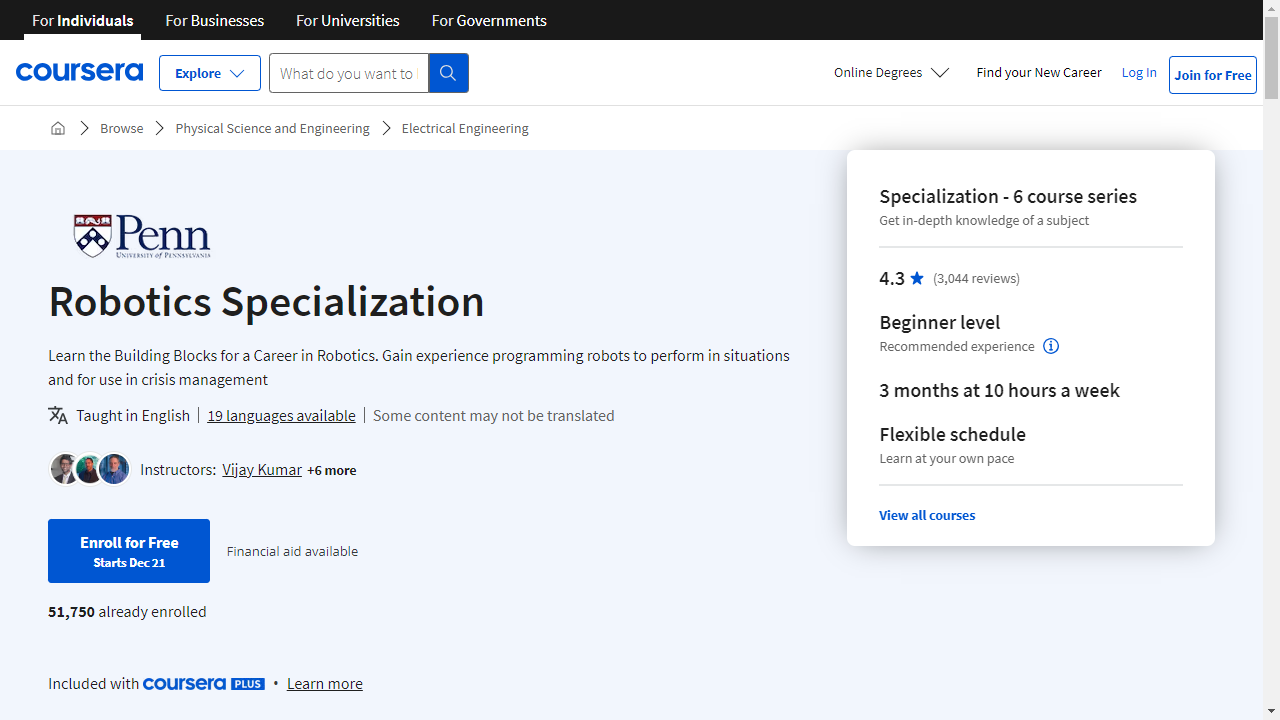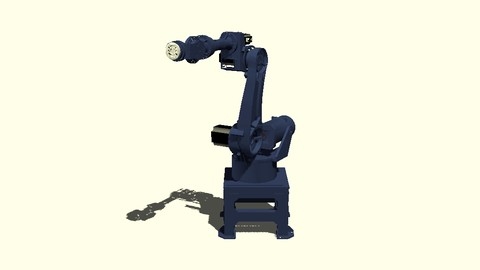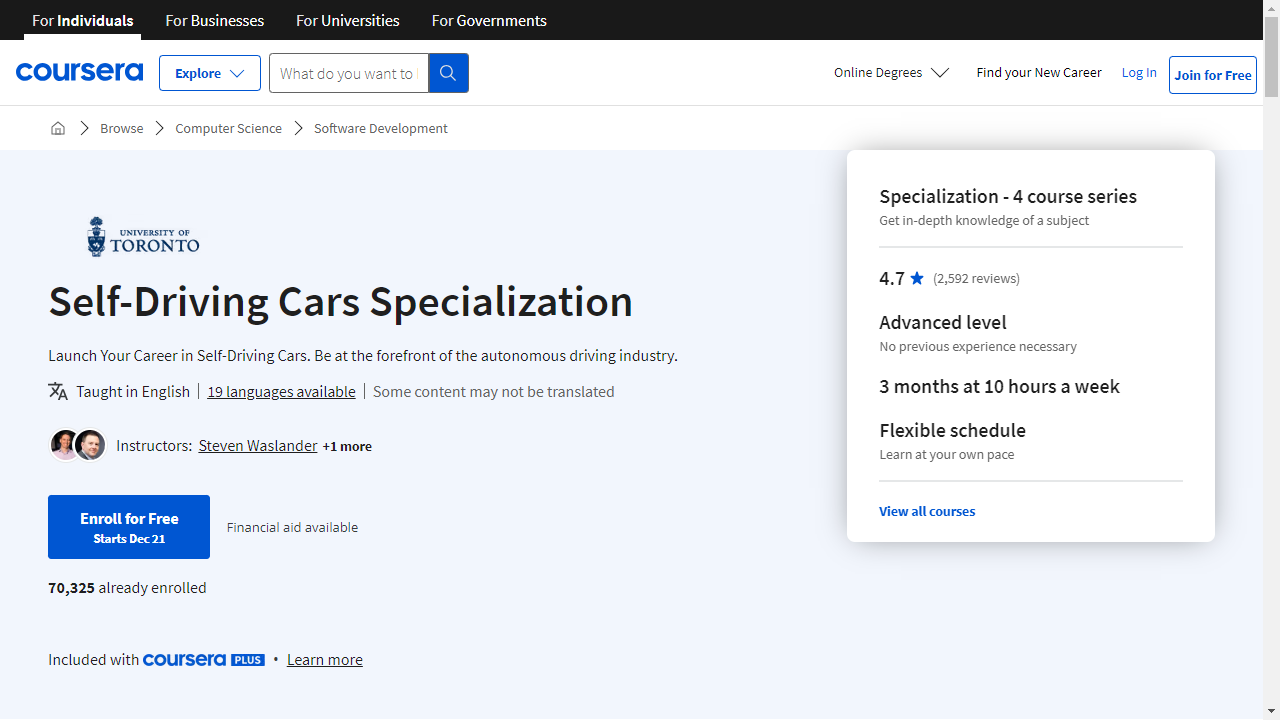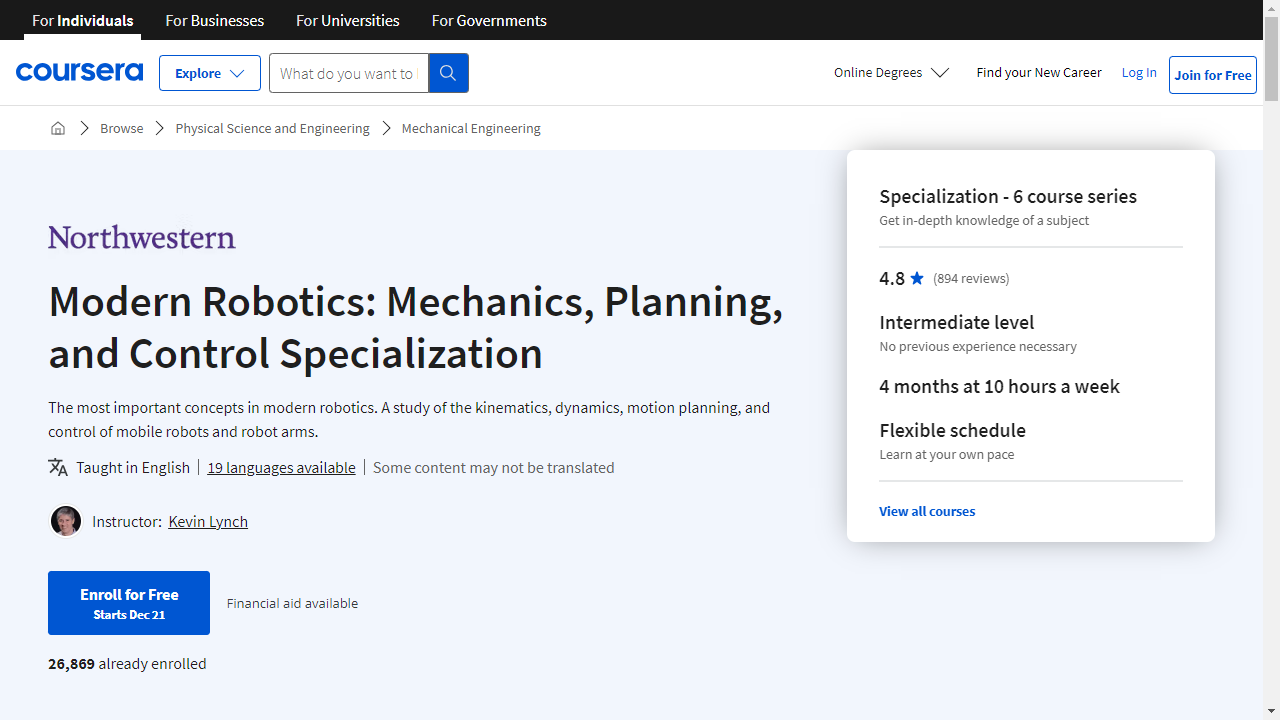Robotics is a fascinating field that combines engineering, computer science, and artificial intelligence to create intelligent machines capable of interacting with the physical world.
Learning robotics can open doors to a wide range of exciting career opportunities, from designing autonomous vehicles and industrial robots to developing cutting-edge medical devices and exploring space.
With the growing demand for robotics expertise, acquiring a solid foundation in this field can be a game-changer for your professional journey.
However, finding a comprehensive and engaging robotics course that suits your learning style and goals can be a daunting task.
You’re looking for a program that not only covers the theoretical foundations but also provides hands-on experience and practical skills that you can apply to real-world robotics projects.
Based on our research and analysis, the Robotics Specialization offered by the University of Pennsylvania on Coursera stands out as the best robotics course overall.
This specialization provides a deep dive into the core concepts of robotics, covering aerial robotics, robot mobility, perception, and state estimation.
It combines engaging video lectures with hands-on projects, culminating in a capstone project where you can choose to simulate a mobile inverted pendulum or build a rover.
While the Robotics Specialization is our top pick, there are other excellent robotics courses available that cater to different learning preferences and areas of focus.
If you’re interested in exploring other options, such as programs focusing on robotics software engineering, industrial robotics, or self-driving cars, continue reading to discover our comprehensive list of recommendations.
Robotics Specialization
Provider: Coursera
The University of Pennsylvania’s Robotics Specialization on Coursera offers a deep dive into the captivating world of robotics.
You will explore everything from basic robot movement to sophisticated ideas like perception and learning.
You will discover how to create robots that can not only traverse difficult environments, but also perceive and interact with their surroundings, and even learn from their experiences.
The specialization begins with aerial robotics.
You will study the mechanics of flight, learn how to design quadrotor robots, and develop controllers that enable these robots to operate in three-dimensional environments.
You will also face the complexities of utilizing sensors for localization and maneuvering in challenging environments.
This course provides a solid understanding of the expanding drone industry and its potential uses.
Next, you will explore how robots use their motors and sensors to move around in unstructured environments.
You will study the kinematics and dynamics of legged robots and learn how to design robot bodies and behaviors that allow for movement in unstructured environments.
You will also explore how robots use cameras and sensors to perceive their surroundings.
You will learn how images and videos are transformed into features and optical flow, allowing robots to grasp objects and navigate using visual odometry and landmarks.
Finally, you will learn how robots use probabilistic generative models and Bayesian filtering to estimate their state and the properties of their environment.
You will learn how robots incorporate uncertainty into their calculations, an essential aspect of developing robots that can function autonomously in dynamic environments.
The specialization culminates in a capstone project where you will choose between simulating a mobile inverted pendulum (MIP) using MATLAB or building an actual rover using a Raspberry Pi, a camera, and an IMU.
Robotics Software Engineer Nanodegree
Provider: Udacity
This four-month program equips you with the skills to build the bots of the future, blending computer vision, machine learning, mechanics, and hardware systems.
You’ll jump into the world of robotics by exploring Gazebo, a simulation tool for robot environments.
You’ll even design your own simulated world!
Next, you’ll master ROS (Robot Operating System), the leading framework for developing robotics applications.
You’ll learn to write ROS nodes, the building blocks of complex robot behavior.
You’ll discover how robots know their location using Kalman Filters and Monte Carlo Localization, even building a Monte Carlo Localization algorithm using C++.
Then, you’ll tackle Simultaneous Localization and Mapping (SLAM), learning how robots create maps of their surroundings while figuring out their position.
You’ll delve into techniques like Occupancy Grid Mapping and GraphSLAM.
Finally, you’ll explore path planning, learning how to enable robots to navigate their environment.
You’ll study both classic and more advanced methods, like sample-based and probabilistic path planning.
There’s even an optional project involving the KUKA robot arm for real-world experience.
And if you’re looking for career support, the program offers resources to optimize your LinkedIn and GitHub profiles and even practice for those all-important autonomous systems interviews.
Industrial Robotics
Provider: Udemy
This course is designed to give you a strong understanding of the core principles of industrial robotics, even if you’re just starting out.
You’ll begin by exploring the mechanical structure of industrial robots, learning about different types of kinematics and the key components that make up a robotic arm.
You’ll gain a solid grasp of coordinate systems and how to use homogeneous transformations to describe the robot’s movements in 3D space.
The course then takes you through the critical concepts of direct and inverse kinematics, teaching you how to calculate the robot’s position and how to make it move to a specific location by controlling its joints.
From there, you’ll dive into path planning, learning how to create smooth and efficient paths for the robot to follow, using techniques like interpolation and Bezier splines.
You’ll also explore workspace monitoring, ensuring the robot can operate safely without colliding with obstacles or itself.
You’ll learn how to generate smooth and efficient trajectories, ensuring the robot’s movements are optimized for speed and accuracy.
The course also covers statics and dynamics, giving you the tools to understand the forces acting on the robot and model its dynamic behavior.
You’ll then explore essential aspects of robot programming, motion control, and calibration, equipping you with practical skills to work with real-world robots.
Finally, you’ll discover how to create a digital twin of a robot using the Unity game engine, allowing you to test your code and experiment in a safe, virtual environment.
Self-Driving Cars Specialization
Provider: Coursera
This specialization equips you with the technical know-how to understand the complex world of self-driving cars.
You’ll start with the fundamentals, learning about the hardware and software that power these vehicles.
You’ll gain a solid grasp of vehicle modeling and control, even getting to write code to control a virtual self-driving car in a simulated environment using Python.
Next, you’ll delve into the crucial aspect of state estimation and localization - figuring out where the car is in its environment.
You’ll become familiar with sensors like GPS and IMUs, learning how to use them for accurate positioning.
You’ll explore powerful techniques like Kalman Filters, which are essential for any aspiring roboticist, and LIDAR scan matching to fuse data from multiple sensors for precise localization.
The specialization then takes you deeper into the fascinating world of computer vision.
You’ll discover how self-driving cars “see” their surroundings, understanding the pinhole camera model and learning to calibrate cameras.
You’ll even design your own convolutional neural networks, a cornerstone of modern computer vision, to tackle real-world problems like object detection and tracking, all within the context of autonomous driving.
Finally, you’ll master the art of motion planning - the “brains” behind a self-driving car’s decision-making.
You’ll explore different levels of planning, from mission planning to local path planning.
You’ll learn to use algorithms like Dijkstra’s and A* to find the most efficient paths, employ finite state machines to make safe driving decisions, and even build occupancy grid maps to ensure your car avoids collisions.
You’ll leave this specialization equipped to design and implement sophisticated motion planning solutions for real-world scenarios.
Robotics and Embedded Systems Nanodegree
Provider: Udacity
This Robotics and Embedded Systems Nanodegree starts you off with stepper motors, teaching you how to control them using device drivers and libraries.
You’ll quickly move on to sensor integration and communication, working hands-on with ultrasonic sensors to measure distance and understand how to implement various communication protocols.
Next, you’ll delve into I2C communication, a critical skill for connecting components in embedded systems.
You’ll master the art of debugging I2C devices and learn to work with accelerometer sensors, which measure motion and acceleration.
This knowledge is essential for building robots that can sense and respond to their surroundings.
You’ll then apply these skills to a challenging Sensor Robot project, allowing you to design and build a robot from scratch.
This hands-on experience solidifies your understanding of the concepts and equips you with practical skills.
Finally, you’ll get assistance with career services, including resume review, LinkedIn profile optimization, and enhancing your GitHub profile.
These resources will help you present yourself effectively to potential employers.
Electricity & electronics - Robotics, learn by building
Provider: Udemy
This course starts with the basics, walking you through concepts like resistance, conductance, and electrical safety.
You’ll learn about DC and AC electricity, and why understanding the differences is crucial for working safely.
The course then dives into essential components like resistors, capacitors, diodes, and LEDs, teaching you their functions and how they interact within a circuit.
You’ll gain practical experience by building circuits on a breadboard, starting with simple LED circuits using a 555 timer and progressing to more complex projects like tone generators and even a police car siren circuit.
You’ll also learn essential skills like troubleshooting, a must-have for any budding electronics enthusiast.
The course doesn’t shy away from more advanced concepts either.
You’ll explore H-bridges used for controlling motor direction, delve into the world of PWM for controlling motor speed, and even learn about op-amps and their applications in areas like audio amplification and biofeedback.
You’ll even get a taste of building your own power supplies, learning about components like transformers and voltage regulators, and understanding how to salvage parts from old electronics.
The course provides a solid foundation in both theory and practice, equipping you with the knowledge and skills to embark on your own robotics and electronics projects.
Modern Robotics: Mechanics, Planning, and Control Specialization
Provider: Coursera
This intensive program, spanning six courses, equips you with the mathematical modeling skills essential for a robotics career or further studies.
You’ll begin with “Foundations of Robot Motion,” mastering the basics of robot configurations, degrees of freedom, and constraints.
You’ll then conquer “Robot Kinematics,” learning to determine a robot’s position and movement based on its joint angles using techniques like forward and inverse kinematics.
Next, “Robot Dynamics” delves into the forces governing robot motion.
You’ll become proficient in calculating a robot’s acceleration from given forces and vice versa, key for simulation and control.
“Robot Motion Planning and Control” then combines these concepts, teaching you to plan collision-free paths for robots and control their movements precisely.
“Robot Manipulation and Wheeled Mobile Robots” takes you further, exploring advanced concepts like grasping, manipulation, and the control of various wheeled robots.
Finally, the “Capstone Project” challenges you to apply your knowledge, creating software to control a real-world mobile manipulator, the KUKA youBot, to perform a pick-and-place task.
This specialization is demanding but highly rewarding.
You’ll utilize the “Modern Robotics” textbook by Lynch and Park, a robotics software library (Python, Mathematica, or MATLAB), and the V-REP robot simulator.
Expect a steep learning curve, but if you’re serious about mastering robotics, this specialization will provide you with a robust foundation.
Introduction to Robotics Nanodegree
Provider: Udacity
This Udacity Nanodegree equips you with the essential skills for understanding robot movement and control.
You’ll begin by diving into actuators, which are like the muscles of robots, and learn how to control them using techniques like Pulse Width Modulation (PWM).
Imagine being able to precisely control the speed of a motor just by adjusting the width of electrical pulses.
You’ll even use a Logic Analyzer, a tool that acts like a detective for electronic signals, to see this process in action.
Next, you’ll explore DC motors, the workhorses that power robot movement.
You’ll discover how encoders, acting as the motor’s eyes, provide feedback on the motor’s position.
Think of it like this: as the motor spins, the encoder sends signals that tell you exactly where the motor shaft is pointing, allowing for incredibly precise control.
You’ll then take your motor control skills further by learning about Servo Motors, a special type of motor that allows for precise positioning – think of them as the precise movers in robotic arms.
Finally, you’ll get to apply your knowledge to a practical project: building a pan and tilt controller for a camera.
This project brings together all the concepts you’ve learned, allowing you to control the camera’s movement using your newfound robotics skills.
And because a strong online presence is crucial in today’s job market, the program helps you optimize your LinkedIn and GitHub profiles, giving you an edge in your robotics career journey.
Hands-On Robotics with Arduino, Build 13 robot projects
Provider: Udemy
This course begins by introducing you to the world of Arduino, a popular microcontroller.
You’ll discover how to set up the Arduino IDE (the software used to program it) on your Windows computer and even learn to write code to control an LED – a fundamental skill in robotics.
You’ll then dive into the hands-on part, building a robot from scratch using a chassis, DC motors, and a motor driver, understanding how each component contributes to the robot’s movement.
You’ll discover the crucial role of an H-bridge circuit in controlling the direction of the motors and how to write code to make your robot move forward, backward, and execute precise turns.
But the learning doesn’t stop there.
This course introduces you to serial communication, enabling you to control your robot from your computer using a potentiometer sensor.
Then, you’ll step into the world of Android app development using AppInventor2.
Imagine creating your own Android apps to control your robot wirelessly – with this course, you can!
Things get even more exciting as you explore the use of your smartphone’s built-in sensors.
Learn to control LEDs and robots using Bluetooth and even explore the fascinating world of accelerometer and voice recognition technology.
Imagine controlling a robot by tilting your phone or using voice commands – this course empowers you to do just that.
Also check our posts on:









